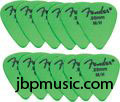Epiphone Les Paul Classic Quilt-Top Review
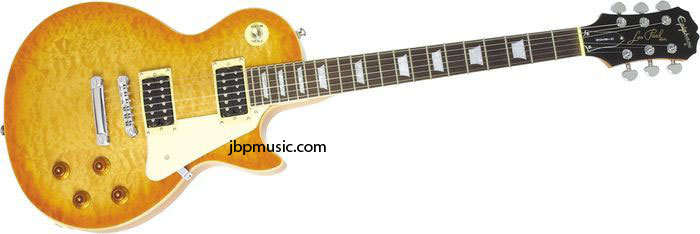
Epiphone Les Paul Classic Quilt Top Review
Over the years, there have been many guitars I have played and loved. One guitar, however, has been consistently my favorite to play - the Les Paul. I love Firebirds, Stratocasters, Telecasters, SGs, Ibanezs, PRSs and lists of others. But, time after time, I always come back to a Les Paul. The way they play, sound, feel, and look just says something to my soul. I know that Les Pauls aren't for everyone - no problem. They're just wonderful to me.
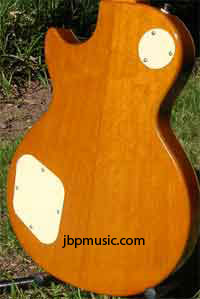
Quick Opinion: The Epiphone version of the Les Paul Classic Quilt Top is a well-done rendition, with great features and decent sound. The guitar does not approach its Gibson cousin, but is definitely worth its price and then some.
The Epiphone Les Paul Classic is not currently in production, but you can find out more about Epiphone Les Paul guitars and get Free Shipping at GuitarCenter.com
Playability: In the world of Les Pauls, there are two main camps. Those that like thick necks and those that like more modern C-shaped necks. The Epiphone Les Paul's neck is much more comperable to a modern Tele or Strat than a 50s Les Paul. The neck is slightly less beefy than the 60s-neck Gibson Les Pauls, and significantly less beefy than the 50s-neck Gibson Les Pauls. If you're a modern Fender fan, the Epihpone will probably feel much more at home than the Gibson necks. If you're used to Ibanez electrics or modern ESP/LTDs, for example, you'll find the Epiphone very similar.

The neck plays like greased lightening, and is very comfortable from a grip point of view. The string spacing is excellent for most hands, and the string height is actually superb - right out of the box. In general, Les Pauls have a short-ish scale length (means, the length of the string is a little less than the average guitar). The shorter scale makes thicker strings a little more comfortable to play, and makes reasonable string-bending possible with 10s or 11s.
The balance of neck and body is good, and the fretboard is comfortable and smooth. Some may find the weight of Les Pauls (in general) a bit much to lug for hours at a time, but I think it is a reasonable trade-off for the MILES of sustain and depth of the guitar's sound.
Features The Epiphone Les Paul Classic Quilt top is very high in the features list arena. Were this a Gibson, the features of this guitar would be between a Les Paul Studio and a Les Paul Standard. The single-ply cream-colored binding is applied to the top edges and the fretboard. The back is pretty much a natural mahogany color, and the entire guitar is gloss finish (including the back of the neck). The quality of the smoothness of the finish is very good, although my particular guitar has a few blemishes underneath the top coat on the back (almost like a filler was applied to the wood, then finished over without coloring the filler).
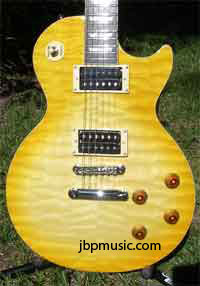
The Classic Quilt Top is actually a beautiful instrument, with mahogany body and quilted maple carved cap/top. The fretboard is a comfortable and nice quality rosewood, and the headstock overlay is fairly well done. The stop-bar tailpiece is standard Gibson stuff, as is the Tune-o-matic bridge. The guitar sports two tone knobs and two volume knobs, with one of each for each of the two pickups. My Classic came with superb, chrome full-sized Grover tuners. Epiphone appears to have made the switch from the jade-keystone-two-screw vintage tuners not long before my instrument was made - all the catalogs and internet sites still showed the guitar with the vintage tuners and not Grovers. (As an aside, I found some new Gibson-authorized Grover chrome tuners that have the keystone/tulip shape for the tuner buttons - and they were a direct replacement for the factory Grovers. I just like the keystone shape of the tuners better than the butterbean shape.)
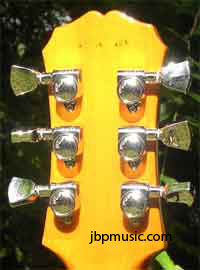
Overall, the Epi Classic is complete with features that compare favorably with other, nicer Les Pauls.
Sound: Sustain, sustain, clarity, clarity, and clarity. When you look up sustain in the dictionary, there's a picture of my Les Paul. Nuff said.
The pickups are a little on the low-output side (although still better than the Classic's less expensive siblings). When compared to Burstbuckers or Classic Gibson pickups, the edge, bite, and growl are significantly more tame with the Epi's pickups. But to put them in real perspective, they are more versatile, warmer, and more creamy than any other humbucker I've played in guitars in the same price range. Pickups are almost a matter of preference - when concerning their overall sound. Some like the visceral sound of EMGs, some like the mellow twangy-beefy of Fenders, and others like the true-blue broad-spectrum sound of Burstbuckers. The pickups in the Epi are most comperable to the Gibson humbuckers, but with less output and less tonal range. I realize I ramble on this part of the subject, but I think most will agree that you will always want more pickup sound (unless you've bought a top-of-the-line Gibson/Fender/Etc.).
The sound of this particular Epi Les Paul is good for rock (almost all types), good and gutsy blues, electronica, and some forms of traditional metal.
Value: This is a $550 guitar in value (not 'retail', 'street'). This guitar is significantly nicer than the lower-end Epi Les Pauls, and is an excellent value for the money, the sustain, and the features.
Wishes: I love my Les Paul. Even when my budget will allow me to buy the Gibson Les Paul Standard of many a dream, my Epi will still get lots of play time and recording time.
However - The finish flaws on the back side could have been avoided. Also, as seems typical of many Chinese Epis, my guitar's lead wire solders were not very good. I had to re-solder most of the wiring into the pots before I could get the guitar to behave correctly (as was true of at least 6 other classics at my favorite guitar stores).
I do wish the pickups were covered with nickel covers. I do think the sound might change a bit with nickel covers - but to me, after looking at Les Pauls for so many years, nickel-covered pickups were traditional. Perhaps this model could be offered with more than one type of pickup system.
Labels: classic, electric guitar, epiphone, epiphone les paul, guitar, set neck


